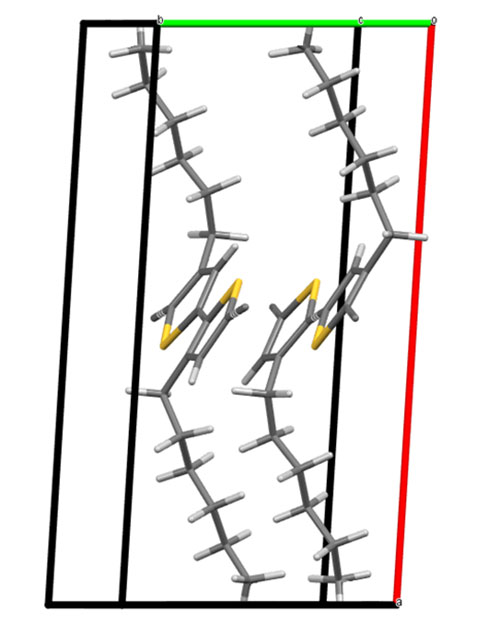Resonant X-ray Diffraction Reveals Backbone Tilt in Polymers
New method helps scientists to better understand conjugated polymers for applications in solar cells and electronics
August 10, 2022
 enlarge
enlarge
Molecular packing of the polymer poly(3-hexylthiophene). (Image courtesy of G. Freychet et. al. Materials Hori. 9 (6), 1649-1657 (2022).)
The Science
By employing resonant tender x-ray diffraction, scientists resolved the tilt of the backbone of a conjugated polymer, an important structural feature that is otherwise hard to discern with other research tools and has eluded measurement.
The Impact
Conjugated polymers, due to their unique electronic and optical properties, have applications in solar cells and electronics; however, scientists have a hard time pinning down the precise molecular alignment in these polymers and its expected relationship to their properties.
Summary
From solar cells to electronics such as light emitting diodes and transistors, conjugated polymers with electronic and optical properties open a new pathway for energy-efficient, low-cost, lightweight, flexible electronic devices. However, scientists need to discern the internal atomic stacking of these semicrystalline polymers to fine-tune their properties for such devices. Until now, revealing the details of such inner structures—even for well-studied polymers—was beyond most experimental techniques.
In this study, a team of international researchers collaborated with scientists at the National Synchrotron Light Source II (NSLS-II) to reveal the backbone tilt in crystalline poly(3-hexylthiophene), a well-known conjugated polymer, for the first time. The researchers used the Soft Matter Interfaces (SMI) beamline at NSLS-II to measure a backbone tilt of 30 +/- 5 degrees with respect to the side chain stacking direction. The team not only used resonant tender x-ray diffraction to make this discovery but also harnessed the additional polarization-dependent effects of the polymer’s molecular orientation during the measurement.
This discovery demonstrates the uncanny power of resonant x-ray diffraction to harness polarization for the study of conjugated polymers, enabling researchers to take a new look at polymers.
The SMI beamline is part of the soft matter and complex scattering tools available at NSLS-II. As a U.S. Department of Energy Office of Science User Facility, NSLS-II offers access to advanced materials characterization and life science tools through a free peer-reviewed access policy.
Download the research summary slide (PDF)
Contact
Christopher R. McNeill
Monash University
christopher.mcneill@monash.edu
Publications
G. Freychet, P. Chantler, Y. Huang, W. Liang Tan, M. Zhernenkov, N. Nayak, A. Kumar, P. A. Gilhooly-Finn, C. B. Nielsen, L. Thomsen, S. Roychoudhury, H. Sirringhaus, D. Prendergast, C. R. McNeill. Resolving the backbone tilt of crystalline poly(3-hexylthiophene) with resonant tender X-ray diffraction Materials Horizons 9 (6), 1649-1657 (2022). [DOI: 10.1039/D2MH00244B]
Funding
This research used the Soft Matter Interfaces (SMI) beamline (Beamline 12-ID) of the National Synchrotron Light Source II, a U.S. Department of Energy (DOE) Office of Science User Facility operated for the DOE Office of Science by Brookhaven National Laboratory under Contract DE-SC0012704. Work at the Molecular Foundry was supported by the Office of Science Office of Basic Energy Sciences, of the U.S. Department of Energy under Contract No. DE-AC02-05CH11231. This work was also conducted in part at the Soft X-ray and SAXS/WAXS Beamlines at the Australian Synchrotron, part of ANSTO. HS acknowledges financial support from the European Research Council for a Synergy grant SC2 (no. 610115) and from the Engineering and Physical Sciences Research Council (EP/R031894/1). The authors thank Martin Brinkmann (CNRS) and Vincent Lemaur (University of Mons) for discussions and sharing unit cell data.
2022-20880 | INT/EXT | Newsroom









